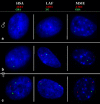A cross-species comparison of escape from X inactivation in Eutheria: implications for evolution of X chromosome inactivation
- PMID: 21947602
- PMCID: PMC3260438
- DOI: 10.1007/s00412-011-0343-8
A cross-species comparison of escape from X inactivation in Eutheria: implications for evolution of X chromosome inactivation
Abstract
Sex chromosome dosage compensation in both eutherian and marsupial mammals is achieved by X chromosome inactivation (XCI)--transcriptional repression that silences one of the two X chromosomes in the somatic cells of females. We recently used RNA fluorescent in situ hybridization (FISH) to show, in individual nuclei, that marsupial X inactivation (in the absence of XIST) occurs on a gene-by-gene basis, and that escape from inactivation is stochastic and independent of gene location. In the absence of similar data from fibroblast cell lines of eutherian representatives, a meaningful comparison is lacking. We therefore used RNA-FISH to examine XCI in fibroblast cell lines obtained from three distantly related eutherian model species: African savannah elephant (Loxodonta africana), mouse (Mus musculus) and human (Homo sapiens). We show that, unlike the orthologous marsupial X, inactivation of the X conserved region (XCR) in eutherians generally is complete. Two-colour RNA-FISH on female human, mouse and elephant interphase nuclei showed that XCR loci have monoallelic expression in almost all nuclei. However, we found that many loci located in the evolutionarily distinct recently added region (XAR) displayed reproducible locus-specific frequencies of nuclei with either one or two active X alleles. We propose that marsupial XCI retains features of an ancient incomplete silencing mechanism that was augmented by the evolution of the XIST gene that progressively stabilized the eutherian XCR. In contrast, the recently added region of the eutherian X displays an incomplete inactivation profile similar to that observed on the evolutionarily distinct marsupial X and the independently evolved monotreme X chromosomes.
Figures


References
-
- Amar LC, Dandolo L, Hanauer A, Cook AR, Arnaud D, Mandel JL, Avner P. Conservation and reorganization of loci on the mammalian X chromosome: a molecular framework for the identification of homologous subchromosomal regions in man and mouse. Genomics. 1988;2(3):220–230. doi: 10.1016/0888-7543(88)90006-7. - DOI - PubMed
Publication types
MeSH terms
Substances
LinkOut - more resources
Full Text Sources

